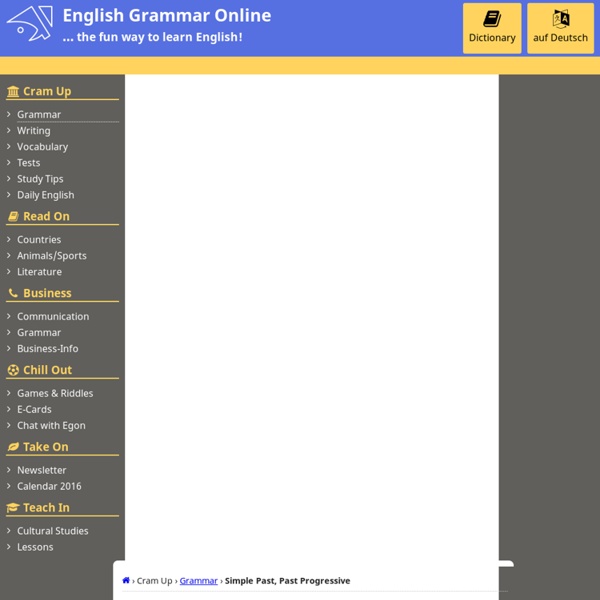Past Tense - Simple or Progressive 2 - English Grammar Exercises
Fill in the correct form of the PAST TENSE (Simple or Progressive) The lights out as we the plans for the wedding (GO, DISCUSS) I on a road in the mountains when I out of petrol. (DRIVE, RUN) "What between 5 and 7 yesterday afternoon? (YOU DO) - I in the Red Lion Pub with a lot of other people. (SIT) The singer his best hits while the fans over the fence. (SING, CLIMB) While the woman into the bus, the driver suddenly .
Simple Present vs. Present Progressive
Exercises and tests Form See also explanations on Simple Present and Present Progressive Use In general or right now? Do you want to express that something happens in general or that something is happening right now? Timetable / Schedule or arrangement? Do you want to express that something is arranged for the near future? Daily routine or just for a limited period of time? Do you want to talk about a daily routine? Certain Verbs The following verbs are usually only used in Simple Present (not in the progressive form). state: be, cost, fit, mean, suitExample: We are on holiday. possession: belong, haveExample: Sam has a cat. senses: feel, hear, see, smell, taste, touchExample: He feels the cold. feelings: hate, hope, like, love, prefer, regret, want, wishExample: Jane loves pizza. brain work: believe, know, think, understandExample: I believe you. Exercies on Simple Present and Present Progressive Tests on Simple Present and Present Progressive
past continuous - 01
This website uses cookies to ensure you get the best experience on our website More info Cookie Consent plugin for the EU cookie law AddThis Sharing Buttons Share to FacebookFacebookShare to EmailEmailShare to BloggerBloggerShare to WordPressWordPressShare to MoreMore Custom Search English language quizzes Past simple and past continuous tenses - anecdote - the Donkey-Dog Gap-fill exercise Fill in all the gaps, then press "Check" to check your answers. This about ten years ago. Resources page for past continuous ESL lesson plans Reading and vocabulary: workplace discrimination Pic: stokpic (CC) Work clothing vocabulary. Download Dress code (PDF) Reading and vocabulary: How Donald Trump got rich: a tale of three Trumps Pic: Michael Vadon (CC) Three articles in graded English with lead-in and comprehension tasks. Download Intermediate (PDF) Download Advanced (PDF) © ELTbase 2008 - 2018 All rights reserved | Privacy and cookies | About | Page Top ↑
Simple Past vs. Present Perfect Simple
Exercises and Tests Form See also explanations on Simple Past and Present Perfect Simple Use In British English, the use of Simple Past and Present Perfect is quite strict. Note that the following explanations and exercises refer to British English only. Certain time in the past or just / already / yet? Do you want to express that an action happened at a certain time in the past (even if it was just a few seconds ago) or that an action has just / already / not yet happened? Certain event in the past or how often so far? Do you want to express when a certain action took place or whether / how often an action has happened till now? Emphasis on action or result? Do you just want to express what happened in the past? Signal Words Exercises on Simple Past and Present Perfect Simple Tests on Simple Past and Present Perfect Simple
Present Perfect Simple vs Present Perfect Progressive
Exercises and Tests Form See also explanations on Present Perfect Simple and Present Perfect Progressive Use Both tenses are used to express that an action began in the past and is still going on or has just finished. Result or duration? Do you want to express what has happened so far or how long an action has been going on yet? Certain verbs The following verbs are usually only used in Present Perfect Simple (not in the progressive form). state: be, have (for possession only)Example: We have been on holiday for two weeks. senses: feel, hear, see, smell, taste, touchExample: He has touched the painting. brain work: believe, know, think, understandExample: I have known him for 3 years. Emphasis on completion or duration? Do you want to emphasise the completion of an action or its continuous course (how has somebody spent his time)? Result or side effect? Do you want to express that a completed action led to a desired result or that the action had an unwanted side effect? Permanent or temporary?



